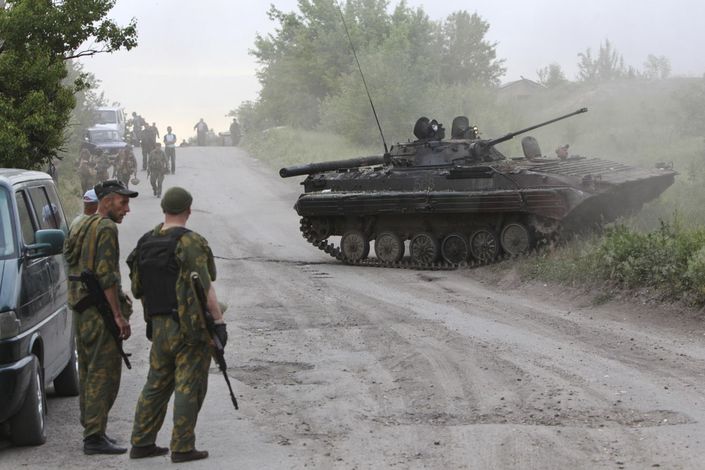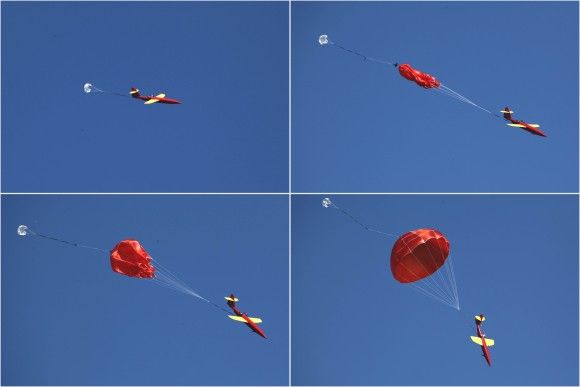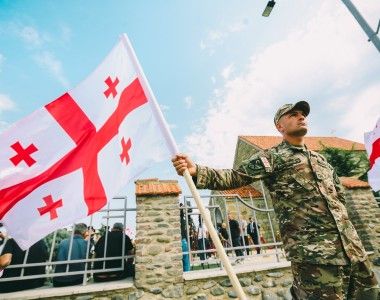Donbass Coup D’état - a report of Warsaw Institute
A coup d’état took place in Luhansk area of the occupied region of Donbass at the end of November. As a result, Igor Plotnitsky was replaced by Leonid Pasechnik. Such a change constitutes the victory of the FSB and, at the same time, the defeat of Vladislav Surkov along with the allied GRU forces. The Luhansk coup has not changed relations between Moscow and Kiev; it has not contributed to the international prognosis on Donbass, either.
The situation in the occupied part of Donbass
Growing tensions in the environment of pro-Russian rebels in the occupied part of the Donbass are visible not only in Luhansk but also in the so-called Donetsk People’s Republic (DPR). During the coup in Luhansk, a series of unexplained explosions occurred in an ammunition depot in Donetsk; in addition, the main local rival of the “president” Alexander Zakharchenko, Alexander Khodakovsky, became more active in the region. The tightening of internal conflicts among the rebels was unavoidable for three main reasons.
- “Republics” are typical “war” states, extremely militarized, whose main aim is to wage war against Ukraine. In the light of a relatively long time of peace on the front (no major war operations have been conducted), war-oriented warlords have begun to look for some enemies inside the region.
- It seems clear that Russia has been seeking a political settlement of the conflict. Such a state of affairs has raised the concern of the majority of current republic leaders, who, as participants of the 2014–2015 war activities, would probably become redundant, or even detrimental to Moscow, if there was any agreement with Kiev and Western countries. Recent discussions about the introduction of UN peacekeeping forces in the Donbass, which is an idea advocated by Putin himself (on his own terms, of course), have had to increase the anxiety of the rebels.
- The economic and social situation in the occupied part of the Donbass is still deteriorating. This is due not only to the more decisive actions of Ukraine, such as sealing the blockade, but also to Russia’s economic problems as it is less eager to subsidize “people’s republics”. Thus, there emerges an increasing competition between local commanders and “officials” to get their dwindling resources and influence. Russia may send less money; moreover, incomes from contraband have already decreased.
The events which had taken place between November 21 and 24 showed the disproportions between the two parts of the occupied zone. Contrary to the outward message, which constitutes an effect of the Russian propaganda, “Donetsk People’s Republic” (DPR) and “Luhansk People’s Republic” (LPR) can only be comparable in terms of their territories. Out of these two, Donetsk has always been definitely stronger in the domain of politics, military and economy. “President” Zakharchenko has managed to pacify the internal opposition in a quick and efficient way. Some of the 2014 rebellion leaders have fled to Russia (e.g. Igor Girkin AKA Strelkov or Alexander Borodai) whereas others were killed on the spot (e.g. Arsen Pavlov “Motorola” or Mikhail Tolstykh “Givi”). Today, “Donetsk People’s Republic” constitutes a centralised state ruled by a siloviki group under the leadership of Zakharchenko. His right-hand man is Alexander Timofeyev (nom de guerre Tashkent), who is also responsible for economic and financial issues.
A completely different situation could be noticed in the “Luhansk People’s Republic” from the very beginning. First, its “head” (this is the official name of the most important person in the “state”), Igor Plotnitsky, was much weaker than Zakharchenko. For a very long time, his real power was limited only to the Luhansk territory while the republic resembled rather a loose federation of quasi-states governed by various commanders and atamans. Alchevsk was ruled by Alexei Mozgovoi whereas in Stakhanov, it was Pavel Dremov. Pervomaisk was under the leadership of Russian Cossacks and Krasnyi Luch was led by Anatoly Kozitsyn, the self-proclaimed ataman from Novocherkassk. With the support of the GRU forces and mercenaries from Wagner Company, Plotnitsky managed to eliminate the above-mentioned warlords. Most of them died in attacks, only a few of them fled to Russia. The problem is that the consolidation of the “republic” did not mean the one-man rule since Plotnitsky had some rivals in power structures. Along with an extensive corruption system of embezzlement of the Russian funds and a well-developed cooperation with Ukrainians within the framework of contraband, it is not surprising that Plotnitsky’s relations with Moscow have gradually deteriorated. It has been rumoured about his resignation for a long time.
Russian supervision over “people’s republics”
Some groups in the occupied Donbass have their curators in Russia. “People’s republics” constitute a Russian idea. From the very beginning, Moscow has had a decisive voice there, especially in military and security matters. Moreover, it was the Kremlin who wanted Zakharchenko and Plotnitsky to become the formal leaders of the “republics”. However, it does not mean that Moscow decides about what is happening in the occupied part of the Donbass. The “turf war” in Donetsk and Luhansk began in the summer of 2014 when the Federal Security Service of the Russian Federation (FSB) did not manage to prepare a rebellion in southeast Ukraine; moreover, it did not succeed in protecting the rebellion commanders against an inevitable defeat in a conflict with the Ukrainian forces as the former had been rescued due to the entrance of the Russian army. Since that moment, it was Main Intelligence Directorate (GRU) that has become an important and a very influential service in the Donbass. However, the war was over and the occupied zone should have been arranged in a “civil” way. Then, the FSB forces went into action and, as a result, both civilians and soldiers could share their influence. Of course, the GRU was responsible for controlling the rebel “armed forces” while the FSB decided about the cast of force structures: in both “republics”, “Ministry of the Internal Affairs” and “Ministry of State Security” were formed. Moreover, a Lubyanka curator, Sergey Beseda, had been the most important official responsible for former Soviet republics. However, the supreme and political control over the entire occupied zone was carried out by the administration of the Russian president, more precisely, by Putin’s advisor, Vladislav Surkov, and his people. Surkov has already had some experience in managing similar “projects” – Abkhazia and South Ossetia. Basically, there are two distinct ideas for Donbass represented by two “camps”. Surkov and the GRU are in favour of reintegrating Donbass with the Ukraine but the region would be granted a great deal of autonomy; moreover, it would remain under Russia’s influence to be able to control the Ukrainian politics from the inside. Such a choice is motivated both by political and economical reasons; it would be a step towards removing Western sanctions while Moscow’s financial help is becoming more and more costly. A completely different approach is advocated by the FSB officers as, according to their rule, the siloviki will not be eager to return the territory they have already “conquered”. Lubyanka is in favour of unification of the “republics”; in addition, its aim is to make them highly militarised, which could possibly be a threat to Kiev

The division in Moscow could be directly transposed into the balance of power in Luhansk. Currently, Surkov was responsible for most of the “administration”, “Luhansk People’s Republic” along with Plotnistky, his people and the “parliament” referred as the “People’s Council”. The FSB dealt with “power” ministries represented by the “Ministry of Internal Affairs” (Igor Kornet) and “Ministry of State Security” (Leonid Pasechnik). As for the GRU, it is in charge of the “army” in Luhansk known as “People’s Militia” (whose commander is the officer of the Russian army, General Yevgeny Nikiforov), which constitutes the base of the 1st Army Corps, organized on the model of the Russian army, staffed by many Russian officers and subordinate to the Russian command.
Plotnitsky versus siloviki (2015-2017)
Plotnitsky’s conflict with the siloviki had some economical background and, more precisely, they fought for the division of profits gained thanks to the fuel sector. In October 2015, the LPR’s “Ministry of State Security” arrested Dmitry Lyamin, the LPR “energy minister” and a Plotnitsky associate. In response, Plotnitsky dismissed “State Security Minister” Leonid Pasechnik until the situation could be clarified. Igor Kornet, a head of the interior ministry, came to his defence as both men are subordinated to the FSB. As a result, Plotnitsky dismissed Kornet. The conflict began to escalate when the siloviki had been supported by Plotnitsky’s enemies: LPR’s “Prime Minister” Gennadiy Tsypkalov, chairman of the “People’s Council” Aleksey Karyakin as well as Cossack commander Pavel Dremov and “mayors” of Brianka and Krasnyi Luch. The “Luhansk People’s Republic” was on the brink of civil war so Moscow had to intervene. It may have been some arrangements between Lubyanka and the Kremlin; as a result, a compromise was introduced in the region. Eventually, both Pasechnik and Kornet came into force again but Tsypkalov and Karyakin, who did not have such strong connections in the FSB structures, lost their positions. In this way, Plotnitsky had to give way to the siloviki and accept the losses in the fuel sector; on the other hand, the managed to get rid of uncomfortable people from the two most important offices in the civilian administration. Nevertheless, it did not put end to the conflict that had been only attenuated. A hit-and-run tactics began and, as its result, many officials were killed.
A month and a half after the crisis, Pavel Dremov was killed in a car bombing. A year after, in August 2016, Plotnitsky’s enemies struck a counterattack; as a result, the LPR’s leader was wounded in a bomb attack. It was no accident that both his parents, who lived in Russia, died in September. The official cause of death was mushroom poisoning. This time, Plotnitsky decided to strike with all his strength. He declared that there had been a coup attempt, he accused the siloviki of inaction and got the manpower from the Donetsk’s Sparta Battalion. There was a wave of arrestations. Both interior minister and security state minister were out of his reach so he took revenge on other officials. For instance, former “prime minister” Tsypkalov and one of the heads of People’s Militia, Vitaly Kiselev, were jailed. Karyakin managed to flee to Russia. Shortly thereafter, Tsypkalov’s dead body was found in his cell; according to the official announcement, he hanged himself, though he had indeed died from the torture he had been inflicted. In February 2017, one of the heads of the “People’s Militia”, Colonel Oleg Anaschenko, was killed in a car explosion.
In the autumn of 2017, Plotnitsky decided to eliminate other enemies. On October 21, during the meeting of the “People’s Council”, Kornet was attacked by “deputies” from the Plotnitsky’s “camp”. They charged him with a number of charges, including the illegal appropriation of property. In response, on November 5, the head of the “interior ministry” suggested in a video published on the Ministry’s website that Plotnitsky and his “deputies” were the fifth column of Ukraine. Four days later, Plotnitsky publicly humiliated Kornet: the latter was evicted from an illegally occupied home; the situation was recorded by the cameras of local television, faithful to the head of the “republic”. It was Plotnitsky himself who arrived on the spot. The events began to accelerate. On November 10, Plotnitsky openly declared in the “People’s Council” that Kornet should leave his office. Both rivals, of course, were striving for Russian curators’ attention. Moreover, both returned from Russia on the same day, on November 16; Plotnitsky came back from Moscow where he met Surkov’s people while Kornet – from the nearby Rostov region where he talked with the FSB curators. Plotnitsky may have get some support in Moscow because a few days later, on November 20, Kornet was dismissed
Luhansk coup (November 21 – 25)
On October 21, armed men in unmarked uniforms took over the centre of Russian-occupied Luhansk. They boarded entrances to the main administration buildings, set posts and blockages on the streets. They were well armed, had grenade launchers as well as transporters support. It soon turned out that they had belonged the Kornet’s camp supported by members of the “Vitez” units, namely the spetsnaz of the Donetsk “Ministry of State Security”. They ignored Plotnitsky’s appeal to withdraw. Everything became clear when, a few hours after, Kornet’s speech had been published on the website of the interior ministry. He declared that he had not intended to leave the office and, at the same time, announced that his department had detected a conspiracy prepared by “Ukrainian agents”. The key roles were to be played by people from the closest vicinity of Plotnitsky: head of his administration Irina Teytsman, chief of government security Evgeniy Selivertsov and head of local TV Anastasia Shurkaev. According to Kornet, their aim was to mislead Plotnitsky, wrongly accusing the “interior ministry” of breaking the law. The “minister” demanded the dismissal to be cancelled as well as he urged for punishing the “conspirators”.
Still, it seemed that Plotnitsky had many more assets. In his official statement published in the Internet, he commented that the current situation constituted the continuation of staff changes after Kornet’s dismissal. An information warfare started. In the evening, there emerged some rumors that Plotnitsky had fled to Russia, and Kornet had been granted some additional military support from Donetsk (transporters and several dozen trucks with soldiers). The next morning, on November 22, Plotnitsky denied having fled to Russia. The local television showed the “government” meeting, in which he participated. This was his last attempt to defend. Soon after, “little green men” entered the television, which stopped broadcasting. The putschists also occupied Plotnitsky’s last bastion, which was the “prosecutor’s office”. About 50 people were detained, including “prosecutor general” Vitaly Podobry, “military prosecutor” Sergei Rakhno along with their deputies, as well as Vladimir Cherkov, nominated for Kornet’s successor. Other employees were released immediately after the interrogation; they had started to charge their superiors very rapidly.
On the same day, Plotnitsky and Kornet organised their own press conferences. Only a handful of Russian journalists came to the first one whereas the second one was attended by crowds. At that moment, there was no doubt that Plotnitsky had lost that battle. There was only of question how he would be removed from his post. On November 23, the Ministry of State Security, which had been neutral until that moment, overtly opted for Kornet. The column of cars with Plotnitsky and his people (including alleged “Ukrainian agents”) managed to leave Luhansk without any problems. Apparently, it was Russia that banned any physical liquidation of the loser. Plotnitsky was seen at the airport in Moscow, and, on November 25, a statement was published on the official website of the “LPR”, according to whom, the current head of “state” had resigned due to the health problems (as the winners explained, Plotnitsky’s war injuries had renewed), and his responsibilities would be held by “security minister” Leonid Pasechnik until the next elections in November 2018. Soon after, another message appeared on the same page, saying that Plotnitsky had been appointed the official representative of “LPR” for the Minsk Protocol. In a light of such events, the “parliament” was assembled in an urgent mode as it was necessary to adapt the “constitution” to the new facts; according to the document, if the “head” of the “republic” dismisses before the end of the term, the office is assumed by the chairman of the “parliament”.
It seems that Plotnitsky gave up when he had realised that he had been no longer supported by the GRU. So he had no support in the event of a clash with the putschists and it was known that he had had loyalty of the head of intelligence services of the 2nd Army Corps. And, above all, there were mercenaries from the Wagner Company, supervised by the GRU, who had earlier helped Plotnitsky to remove his enemies. Moscow guaranteed him immunity as it did not want a civil war in Luhansk; at the same time, the Kremlin did not aim to risk any problems in the Minsk Protocol (Plotnitsky is one of the representatives who had signed the document).
Why was it Pasechnik, and not Kornet, who had been granted the highest position in Luhansk? This is a well-though decision of the FSB. Due to a huge risk, it was Kornet who was selected to “eliminate” Plotnitsky as he was much less significant player in this game. Kornet is just a former militiaman whereas Pasechnik could be considered in completely different categories. He was recruited by the FSB in 2006 when he worked in the SBU (he spent his entire career in the Luhansk region, where he became the head of the anti-corruption department). That is why Pasechnik took his position in the conflict only when the FSB was about to win. Thanks to this well-calculated neutrality, his position is much stronger now than it would be in the case of Kornet. It is also easier to imagine his cooperation with Plotnitsky as the official representative of Luhansk in the Minsk Protocol.
Conclusions
- The change in Luhansk can be considered as a victory for the FSB as the service has managed to strengthen its positions at the expense of Surkov. Lubyanka took advantage of the fact that both the Kremlin and the army had been recently focused on Syria so it may have been surprising for the GRU.
- Plotnitsky’s defeat was determined by the lack of active support from the GRU. Earlier, both military spetsnaz and mercenaries from the Wagner Company provided Plotnitsky with some military support. The imprisonment of one of the heads of the “People’s Militia” in 2016 and the murder of another one in 2017 would not have been possible without the consent of the GRU, the service responsible for the above-mentioned militia.
- It seems that the FSB and its people in Luhansk took advantage of removing Plotnitsky from this office. It is likely that the scenario of the putsch had been prepared earlier and the services had been waiting for a convenient moment. Plotnisky made a mistake because he thought that, after his telephone conversation with Putin on the exchange of prisoners with Ukraine, his position was so strong that he would be able to attack the siloviki.
- The Luhansk coup d’état proves that there is no single decision-making centre in Russia when it comes to the policy towards the self-proclaimed “republics” and, in fact, towards the occupied zone. Officially, they are supervised by Putin’s top aide, Vladislav Surkov. But there is also a representative of the Russian Federation in the Trilateral Contact Group for the implementation of the Minsk Agreements, Boris Gryzlov, while special services are leading their own policy.
- The Luhansk coup was not yet another special operation conducted by Russia. Moscow was surprised and, judging by the silence in the first few dozen hours of the crisis, the Kremlin did not know what was going on. Therefore, on November 21, Russia introduced just in case a column of several dozen trucks with soldiers and 20 transporters to the “LPR”.
- The events in Luhansk show that, while it is true that the zone remains under absolute Russian rules, Moscow lacks one decision-making center. In some troublesome situations, local vassals throw set at each other’s throats and hope to get some support from their Moscow-based patrons. As a result, the latter are expected to react quickly and their decision are subsequently implemented in Donbass.
- During their internal games, the rebels fell back on a proven solution and they accused the rival of cooperation with Kiev. Kornet accused the group of the most important colleagues of Plotnitsky that they were “Ukrainian agents”. He knew that he did not have to accuse Plotnitsky himself because the loss of the immediate environment would contribute to his failure.
- The Kremlin had to seek a solution that would satisfy the majority of the siloviki in Luhansk, and, at the same time, would not hurt the Minsk Protocol, which is the idea strongly supported by Moscow. For Putin, it would not be profitable to remove one of the signing parties of the Minsk agreements. Moscow is not interested in escalating the Donbass conflict, especially before the elections scheduled for March 2018. It ended with the Plotnitsky’s bloodless dismissal, but, at the same time, his appointment as representative of the “LPR” in the Minsk Protocol shows that Moscow does not want to withdraw from these agreements.
- For this reason, the unification of both “republics” is not possible at this moment. The presence of the Donetsk siloviki in Luhansk, various signals from some of the Luhansk rebels, and finally speculation in the Russian media – all these issues aim to probe the reactions. Such was the case of Zakharchenko and his idea of the united “Malorossiya” (“Little Russia”) proposed in June this year.
- Getting rid of Plotnitsky, although held with the support of Zakharchenko, should constitute a warning signal for the “president” of the so-called Donetsk People’s Republic. In September, Zakharchenko and Plotnitsky met with the curators from the presidential administration where they mentioned the possible personal changes. It turned out that the replacement of the leader was not difficult at all. Two days after the coup in Luhansk, former commander of the Vostok Battalion, Alexander Khodakovsky, announced that he was ready to replace Zakharchenko, with whom he had been in conflict.
Source: Warsaw Institute
Report is available in pdf format on website of Warsaw Institute under link.




